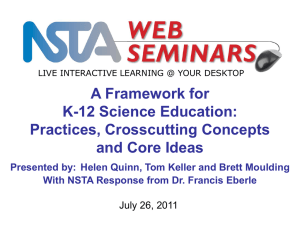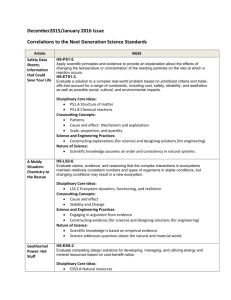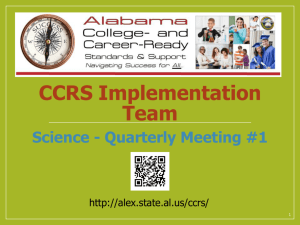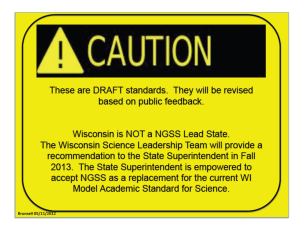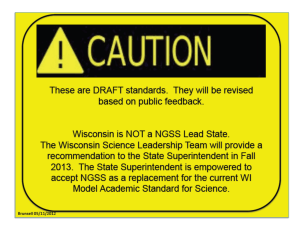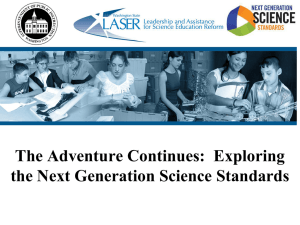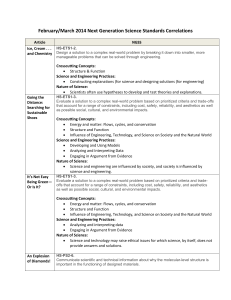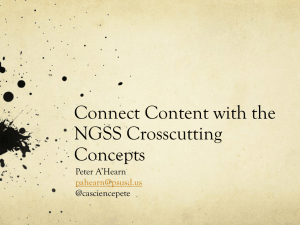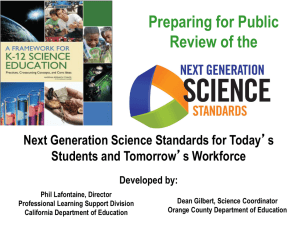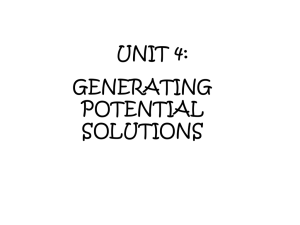“Oh, I remember…”: Discourse makers in young people`s
advertisement
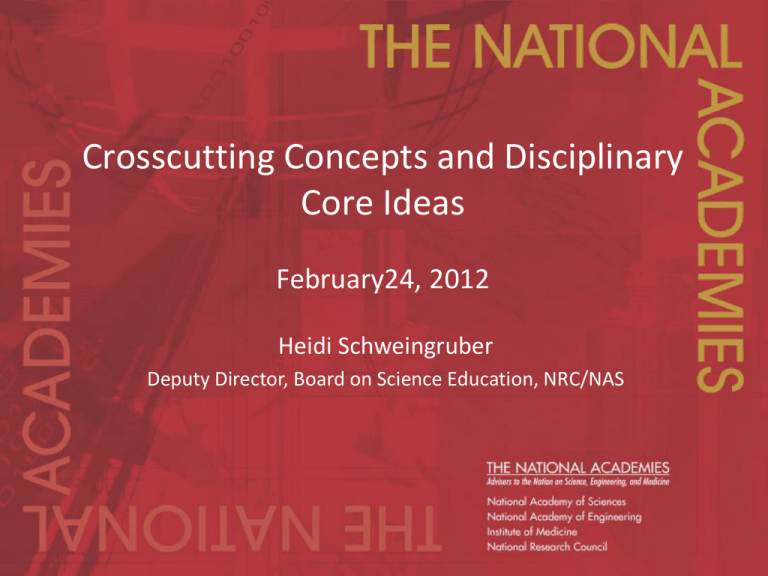
Crosscutting Concepts and Disciplinary Core Ideas February24, 2012 Heidi Schweingruber Deputy Director, Board on Science Education, NRC/NAS Goals of the Framework • Coherent investigation of core ideas across multiple years of school • More seamless blending of practices with core ideas and crosscutting concepts Crosscutting Concepts 1. Patterns 2. Cause and effect 3. Scale, proportion and quantity 4. Systems and system models 5. Energy and matter 6. Structure and function 7. Stability and change Integrating Cross-cutting • Taught in the context of instruction in the disciplinary core ideas NOT in isolation • Use common language to help students recognize the concepts in different contexts • Can help students see connections between ideas in different disciplines A core idea for K-12 science instruction is a scientific idea that: • Has broad importance across multiple science or engineering disciplines or is a key organizing concept of a single discipline • Provides a key tool for understanding or investigating more complex ideas and solving problems • Relates to the interests and life experiences of students or can be connected to societal or personal concerns that require scientific or technical knowledge • Is teachable and learnable over multiple grades at increasing levels of depth and sophistication Disciplinary Core Ideas: Physical Sciences • PS1 Matter and its interactions How can one explain the structure, properties, and interactions of matter? • PS2 Motion and stability: Forces and interactions How can one explain and predict interactions between objects and within systems? • PS3 Energy How is energy transferred and conserved? • PS4 Waves and their applications in technologies for information transfer How are waves used to transfer energy and information? Disciplinary Core Ideas: Life Sciences • LS1 From molecules to organisms: Structures and processes How do organisms live, grow, respond to their environment, and reproduce? • LS2 Ecosystems: Interactions, energy, and dynamics How and why do organisms interact with their environment, and what are the effects of these interactions? • LS3 Heredity: Inheritance and variation of traits How are characteristics of one generation passed to the next? How can individuals of the same species and even siblings have different characteristics? • LS4 Biological evolution: Unity and diversity How can there by so many similarities among organisms yet so many different kinds of plants, animals, and microorganisms? How does Biodiversity affect humans? Disciplinary Core Ideas: Earth and Space Sciences • ESS1 Earth’s place in the universe What is the universe and what is Earth’s place in it? • ESS2 Earth’s systems How and why is Earth constantly changing? • ESS3 Earth and human activity How do Earth’s surface processes and human activities affect each other? Disciplinary Core Ideas: Engineering, Technology and Applications of Science • ETS1 Engineering design How do engineering solve problems? • ETS2 Links among engineering, technology, science and society How are engineering, technology, science, and society interconnected? Why Crosscutting Concepts and Core Ideas? The Power of Conceptual Knowledge • Proficiency in science is more than knowing facts. It is not a simple accumulation of information. • Factual knowledge must be placed in a conceptual framework to be well understood. • Students need to learn how ideas are related to each other, and their implications and applications in the discipline. Prior Understandings • Understanding is constructed on a foundation of existing understanding and experiences. • Prior understanding can support further learning • Prior understanding can also lead to the development of conceptions that act as barriers to learning Conceptual Change in Science • Some kinds of conceptual change occur naturally, some require intentional effort. • For many ideas in science, students are unlikely to arrive at an understanding of them without explicit instruction (for example, understanding atomic-molecular theory or genetics). • Major changes in conceptual frameworks are often difficult and are facilitated by instruction – they take time! Building Conceptual Understanding Learning Develops Over Time • More expert knowledge is structured around conceptual frameworks – Guide how they solve problems, make observations, and organized and structure new information • Learning difficult ideas takes time and often come together as students work on a task that forces them to synthesize ideas • Learning is facilitated when new and existing knowledge is structured around the core ideas • Developing understanding is dependent on instruction Learning Progressions • Sustained exploration of a core set of scientific ideas over months and years. • Core ideas should be central to a discipline of science, accessible to students in kindergarten, and have potential for sustained exploration across K-12. • Findings from research about children’s learning and development can be used to map these learning progressions. Grade-Band Endpoints • Endpoints “sketch” how an idea can be developed across K-12 • Defined for end of grades 2,5,8, and 12 • Provide a set of initial hypotheses about the progression of learning – inform standards and provide a basis for further research Representation of a learning progression Ideas build across the school years to become successively more sophisticated. Responses to assessments Item responses indicate highest level of idea X Highest level of idea X Low level of idea X Increasing sophistication Middle range level idea X Item responses indicate higher level of idea X Item responses indicate medium level of idea X Item responses indicate lower level of idea X Item responses indicate lowest level of idea X Progression for Core Idea: Structure of Matter Highest level Atomic Structure Model – provides a mechanistic model for chemical reaction. By the end of 12th grade By the end of 8th grade Ideas build across the school years to become successively more sophisticated. By the end of 5th /6th grade By the end of 2nd grade Lowest level Atomic/Molecular Model – explains properties and diversity of materials Particle Model – explains phase changes and phases Macroscopic Model – describes matter Progression for Core Idea: Organization for flow of matter Highest and energy in organisms level By the end of 12th grade By the end of 8th grade By the end of 5th grade By the end of 2nd grade More detailed molecular model of chemical reactions for matter and energy in food Chemical reactions model for matter and energy in food, drawing on particle model of matter and energy transfer model Simple food model: food as matter and energy General needs model: Organisms get what they need to survive from the environment. Lowest level Implications for Revising Curriculum and Instruction? Questions to discuss: • For a component idea of your choosing, how is the idea currently treated in curriculum and instruction? • What changes are needed in order to shift to the vision in the Framework? • What crosscutting concepts can be integrated into instruction related to this idea? • What are the first steps you might take to facilitate this shift? Report Out: • Either the top 2 or 3 issues that emerge in your discussion OR • The 1 or 2 first steps your group thinks are most important or promising
